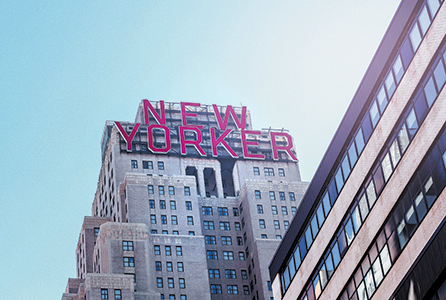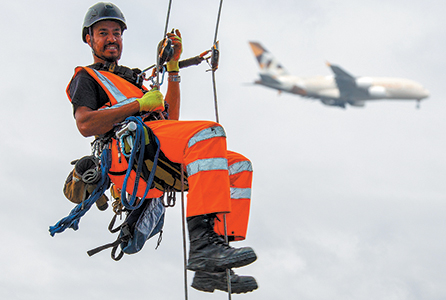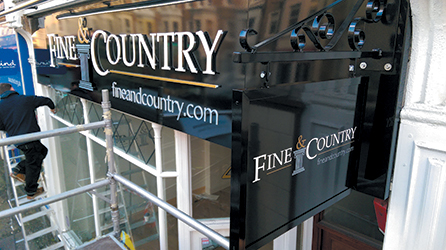
Rope access and scaffolding platforms are two ways to access tricky areas of a building
Reaching new heights
Although it may seem like signs miraculously appear in place at the very top of a tower block, there are in fact a whole hoard of skilled installers, special fixtures, and equipment that is needed to complete work at height. When it comes to choosing the right equipment for the job, each installation is different. From awkward angles, to creating a safe and sturdy platform to use as a base, sign installers are faced with a whole host of challenges when working at height.
In order to prevent death and injury caused by a fall from height, the Work at Height Regulations 2005 exists. The Health and Safety Executive (HSE) explains that the regulations apply to any employer or person who controls working at height, for example facilities managers or building owners who may contract others to work at height – which is often the case in sign installations.
O Factoid: According to HSE, between 2017 and 2018, 35 workers were killed from a fall from height. O
The HSE says on its website: “Employers and those in control of any work at height activity must make sure work is properly planned, supervised and carried out by competent people. This includes using the right type of equipment for working at height.”
In order to make sure work at height is carried out as safely and responsibly as possible, HSE recommends doing as much work as possible from the ground first. Ensuring equipment is suitable, stable and strong enough for the job, and is maintained and checked regularly is another key factor.

Signs will often be placed at the highest point of a building
If access equipment such as a cherry-picker is needed, then a technical survey will highlight any issues that may not have arisen during the site visit. Issues can include accessibility, power supply, terrain, vehicle access and the structural integrity of the building supporting the sign.
Importance of equipment
While it might sound obvious, working at height comes with an array of risks and dangers. This is where the correct implementation of safety equipment is paramount to the safety of workers and installers.
On September 7th, 2016 a roofer was working with a colleague to repair a leaky roof in Seaton Avenue, Felixstowe. Due to a lack of edge protection around the roof and the fact that access to the roof was via an unsecured ladder, the ladder slipped when the worker was accessing the roof causing him to fall approximately two metres.
The roofer sustained contusion and bruising to his head along with hearing damage.
An investigation by HSE found the assessment of the work prior to the arrival of the roofers on site was inadequate. There was neither a system for checking the correct equipment for work at height was being used, nor for supervision of the work on site.
Commenting on the incident, HSE inspector, Prentiss Clarke-Jones says: “This incident so easily could have been fatal; work at height is a well-documented, well-regulated risk and there is no excuse for getting it wrong.”
The tools of the trade
According to the HSE, any equipment that is specifically designed to allow the user to work safely at height (ladders, scaffolds, tower scaffolds) is commonly called ‘access equipment.’ When the surface in which a sign installer is working on is not entirely secure, there is equipment which can be used for collective protection. These include mobile elevating work platforms (MEWPs) such as scissor lifts, tower scaffolds and regular scaffolds.
Workers can also use a work restraint (travel restraint) system that prevents them from getting into a fall position in the first place as a means of personal protection.
If the risk of a person falling remains after these protection measures have been put in place, certain things can be put in place to minimise the distance of the fall. These include safety nets and soft-landing systems, for example air bags installed close to the level of work.
Workers can also use industrial rope access when working on a building façade or a fall arrest system using a high anchor point.
Reade Signs manages the entire installation process using its own experienced team. The firm is used to operating in any environment; on a construction site, at height or on waterfronts with safety at the centre of its operations.
For each project, a specific risk assessment is carried out and a method statement provided for approval. This is also read and signed by the installation team, so they’re fully aware of their responsibilities and how to carry out their work.
To complete work at height, Reade Signs uses a variety of equipment including advanced guard-rail mobile towers, pre-erected tube and clip scaffold, mobile elevating work platforms (cherry pickers) as well as using rope access with dedicated abseil teams.

A Reade Signs team member using rope access to work at height
Andy Fergus Smith, managing director at Reade Signs explains that all crews are trained to use all high-level equipment and the choice of equipment depends on site accessibility and what they are working over. Sometimes, an installation can be tricky and need specialist skills to complete the job. Uncontrollable factors such as the weather can also impact the ability to complete a job. Smith explains: “At the St George development at One Blackfriars, there was no way to gain mechanical access to install giant promotional vinyls, so we used our highly skilled abseil team to install them on the 33rd floor – making it visible across the South Bank.
“Wind conditions are also an incredibly important factor at height and installation is often very weather dependent, which can make it tricky in the winter months; we always have a keen eye on the weather forecast. What we’re working above also dictates the type of access equipment we select.”

Installation is often very weather dependent, which can make it tricky in the winter months”
In terms of safety, Smith explains that while the installation needs to be completed as safely as possible, including ensuring all staff have up-to-date training certification (IPAF, PASMA, IRATA certified) the work to ensure safe installation starts long before the actual installation day.
“Every project requires detailed set-up and planning. Risk and method statement procedures must be outlined. And a structural engineer designs all supporting structures to ensure wind loadings have been considered,” says Smith.
A combination of skills
The Sussex Sign Company delivers nationwide consultancy and support services as well as acting in response to design and fabricating requirements. Like Reade Signs, the firm boasts a range of accreditations and qualifications from Construction Health and Safety Scheme, Safe Contractor Accreditation and Gold Standard Constructionline Certification and more.
To ensure work is always carried out safely and to the highest standard, the Sussex Sign Company’s Directorship Team ensures that all team members are educated, trained and informed of their responsibilities and the Organisation’s Quality Policy is implemented at all levels.
All installation team members have been awarded the International Powered Access Federation (IPAF) Powered Access License (PAL) Card as proof of training. An online working at height training course supports team members to comply with the Work at Height Regulations 2005 by the necessary information needed to successfully deal with working at height risks and control measures.

The Sussex Sign Company’s installation team all hold a Powered Access Card as proof of training
“The Sussex Sign Company’s accreditations and qualifications demonstrate that the organisation has been assessed against both international and nationally recognised standards and operate to the highest levels of quality and service,” explains Linda Edwards, operations director at the Sussex Sign Company.
When it comes to completing installations at height, Edwards explains that the company has a “comprehensive inventory” of access equipment to best support team members to select the most appropriate safe system of work to complete each required task. This includes but is not limited to Hop-Up Platforms, Steps, Ladders and Scaffold Towers.

Reade Signs completed a logistically tricky installation at Kingston University as students continued to attend lectures underneath
To broaden its service capabilities, and to make the most of its team’s qualifications and skills, the Sussex Sign Company also has access to strategically placed independent suppliers of powered access equipment throughout the United Kingdom.
“With the evolving requirement for signage organisations to form part of a much wider multi-disciplinary team, in conjunction with architects, design agencies and such like – for the undertaking of signage commissions, the adoption of a collective approach to knowledge and skill sharing is proving to be essential,” adds Edwards.
In terms of what equipment is currently dominating the market, Smith of Reade Signs says that rope access is the most popular method for tricky installations, and he lists an unlikely tool that could create benefits for the industry: “We’ve seen increasing use of rope access on large residential and commercial properties because it means we can install graphics to windows at very high levels, which provides very effective advertising.

A Sussex Sign Company team member completes an installation using a ladder
“While you can’t install signs with drones, you can survey with them and this can drive down the cost of surveying high level applications.”
By speaking to those working directly on jobs at height, it is clear that there are many steps to a safe and efficient installation. There is the right equipment for any installation, the trick is knowing the options and safely and carefully assessing the job before deciding which to use and where.
Your text here...